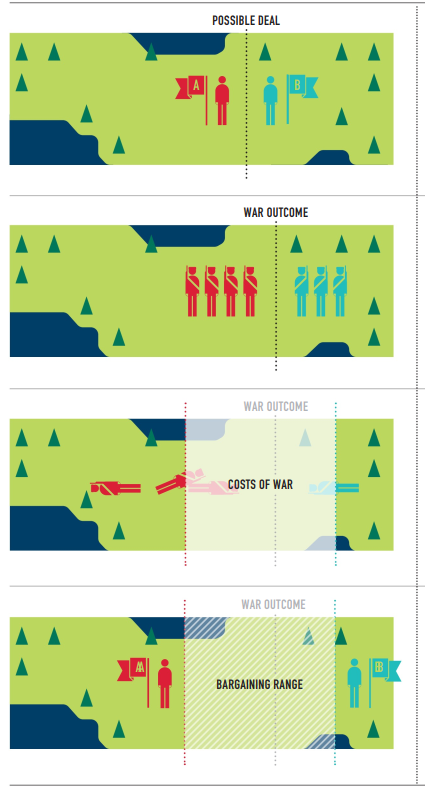Chapter 3 Wars (Week 3)
3.1 Discussion questions
What are the causes of war?
Reiter (2003). What is the bargaining model of war? How does it compare to other theoretical perspectives?
Gartzke and Poast (2017). What is the bargaining model of war? What are the limitations?
What if politicians, businessmen, or the military leaders see wars as less costly or even beneficial? Do states fight wars because of these domestic influences? (*)
Why the Armenia-Azerbaijan conflict is flaring up again | DW News
North Korea thought to be testing parts of a new ICBM system
3.2 Bargaining
Here is a figure (taken from World Politics: Interests, Interactions, Institutions) that showcases the core of the bargaining theory of war: because war is costly, there must exist a deal that leaves belligerents better off than fighting. This is the central puzzle of war as elaborated in Fearon (1995).

To be clear, there are some important existing theories that seek to explain war (e.g. anarchy, misperceptions/mistakes, and special interests). These share some overlaps with the bargaining approach. What the latter approach differ from them is the emphasis on the existing of the bargaining range (i.e. a set of more preferable deals than war). Building on this, the bargaining approach shift the question of why states fight to what precludes from from reaching a deal. Hence, the three (or two) primary explanations.
3.3 What are the theoretical and empirical limitations of the bargaining theory?
- Reiter (2003)
- Gartzkeand Poast (2017)
3.4 Additional resources
Could Mud Cause War between Ukraine and Russia? A Game Theory 101 Investigation
PUTIN’S FOLLY: A CASE STUDY OF AN INEPT STRATEGIST
The growing North Korean nuclear threat, explained [Updated]
Experts Discover North Korean ICBM Base
Interstate War Battle Dataset (version 1.0)
EVERYTHING YOU THINK YOU KNOW ABOUT LIMITED WAR IS WRONG
Check here for a collection of Foreign Affairs analysis concerning the Ukraine crisis. How to Understand the Crisis in Ukraine: The Origins of the War and What Comes Next